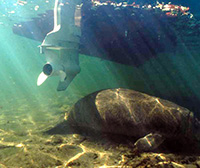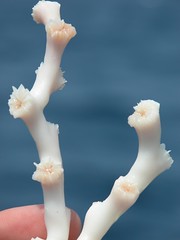A site visit to Harbor Branch
 Saturday, December 11, 2010 at 8:36PM
Saturday, December 11, 2010 at 8:36PM  The submersible Johnson Sea Link aboard R/V Seward JohnsonOn Thursday morning Bruce Carlson and I rose early and headed out to visit Harbor Branch Oceanographic Institute in Fort Pierce Florida; the first visit for both of us. I had long been aware of their marine engineering division and the important role of the R/V Seward Johnson and its attendant submersibles - the Clelia (which we had on display at Georgia Aquarium for a while) and the Johnson Sea Link - in NOAA’s UNOLS oceanographic fleet, but there was much more in awaiting us at that storied campus than I think either of us expected.
The submersible Johnson Sea Link aboard R/V Seward JohnsonOn Thursday morning Bruce Carlson and I rose early and headed out to visit Harbor Branch Oceanographic Institute in Fort Pierce Florida; the first visit for both of us. I had long been aware of their marine engineering division and the important role of the R/V Seward Johnson and its attendant submersibles - the Clelia (which we had on display at Georgia Aquarium for a while) and the Johnson Sea Link - in NOAA’s UNOLS oceanographic fleet, but there was much more in awaiting us at that storied campus than I think either of us expected.
Harbor Branch was established in the early 70’s as a private non-profit ocean research center by J. Seward Johnson, the son of Johnson & Johnson founder Robert Wood Johnson. More recently HBOI became a part of Florida Atlantic University, based a ways up the A1A in Boca Raton
As we toured the site with Assistant Executive Director Megan Davis on the first day, I was first surprised and eventually staggered at the scale of their aquaculture actvities. Their experimental production facilities extend over several acres of spotless Quonset huts on the shores of the Indian River Lagoon and include programs on conch (queen and fighting), clams (hard and sunray venus) and marine snails, though some of their biggest efforts are currently directed towards Florida pompano. Harbor Branch also has an extensive marine drug discovery program that searches for active compounds among the thousands of species in their collection, which might then be used to treat human diseases. There’s a great synergy between that program and the ocean exploration group in that submersibles can bring back new candidate species (especially deep sea sponges) from research cruises around the world, which the clever biochemists and microbiologists can then go to work studying for their potential applications. Its painstaking and tremendously challenging work, but they’ve had at least one anti-cancer drug through to Phase I clinical trials, so the potential is there. Finally there’s a well-established marine mammal program at Harbor Branch, which includes studies on the health of dolphins and manatees in Indian River Lagoon and is responsible for responding to all strandings on that part of the Atlantic Florida coast and the pathology research on those unfortunate animals that don’t make it. The aquarium is intimately involved in these studies because our Cheif Veterinary Officer Dr. Greg Bossart was based at HBOI for many years
On the second day we also toured Oceans, Reefs and Aquariums: a private ornamental fish and coral culture company that is co-located on the HBOI campus and breeds over 70 varieties of marine ornamental fishes. Many people are surprised to learn that marine ornamentals like clownfish, dottybacks, cardinal fish, mandarin gobies and seahorses can be and are bred on commercial scales; there seems to be a well-entrenched dogma that marine species don’t breed in aquariums. Of course, thats not true, they breed all the time. But, as Bruce would say, its not the spawning thats the problem, its the early rearing and especially the need for speciality foods. Why so hard? Well, many species cultured for food have large yolky eggs and big larvae that can feed on common foods like brine shrimp nauplii straight out of their eggs, but reef fishes are different; they often have tiny eggs and larvae that are smaller than many of the food items they might otherwise be fed. Perhaps not surprisingly, those marine ornamentals that have been bred so far have larger eggs than some of their relatives, but successfully rearing fishes like angels and butterfly fish is still proving to be a tremendous challenge. Not so with corals. ORA’s coral culture greenhouse is replete with relatively low-tech trough systems where technicians skillfully “frag” coral colonies (cut little bits off the branches) in exactly the same way as a horticulturist might take cuttings from a plant. The end result is successful multiplication and large scale propagation of many branching, plating and massive corals. This provides a premium marketable product while reducing impact on natural reef systems because no further extraction is needed after the earliest parent colonies. In cheesy business-speak: it’s truly a win-win.
 Happy acroporid coral frags at the ORA facility
Happy acroporid coral frags at the ORA facility
While we were there, Bruce and I also gave seminars about our respective studies - his on resiliance of Fijian coral reefs to bleaching and mine on (what else?) whale sharks. It was a lot to fit into two days, but I came away with a much deeper appreciation for the breadth and depth of programs at one of the world’s best-known marine science facilities. I hope it was the first of many such visits because they’ve got a lot of great stuff going on there.






